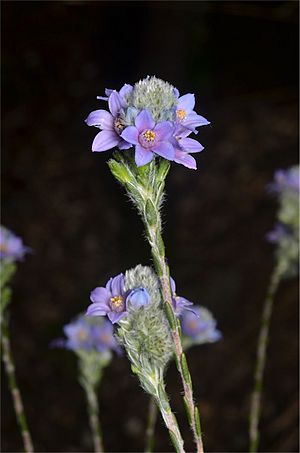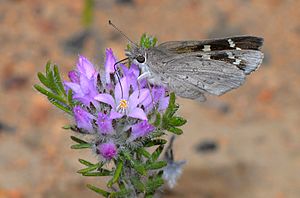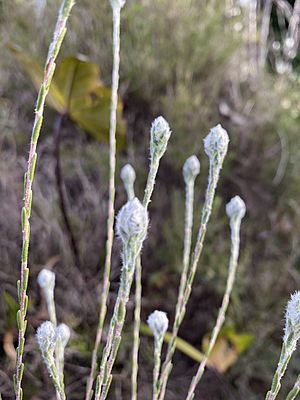Philotheca nodiflora facts for kids
Quick facts for kids Philotheca nodiflora |
|
|---|---|
 |
|
| Subspecies lasiocalyx | |
| Scientific classification | |
| Genus: |
Philotheca
|
| Species: |
nodiflora
|
| Synonyms | |
|
Eriostemon nodiflorus Lindl. |
|
Philotheca nodiflora is a type of flowering plant found only in Western Australia. It belongs to the Rutaceae family, which also includes citrus plants. This plant is a small, weak shrub. It has leaves that are shaped a bit like tubes. Its pretty flowers are blue or pink and grow in tight bunches.
What Does It Look Like?
Philotheca nodiflora is a small shrub. It usually grows to be about 10 to 80 centimeters tall. Its leaves are somewhat round and hollow, like a small tube. They are usually between 5 and 15 millimeters long.
The flowers grow in tight groups. Each group is about 10 to 30 millimeters wide. The flowers sit on short, hairy stems called pedicels. These stems are only 1 to 4 millimeters long.
Each flower has five small, leaf-like parts called sepals. These sepals are about 2 to 5 millimeters long. The flowers also have five beautiful blue or pink petals. These petals are shaped like ovals or eggs and are 5 to 9 millimeters long. Inside the flower, there are ten stamens, which are the parts that make pollen. They are about 4 to 5 millimeters long and are covered in tiny hairs.
How It Got Its Name
This plant was first officially described in 1839. A scientist named John Lindley gave it the name Eriostemon nodiflorus. He wrote about it in a book called A Sketch of the Vegetation of the Swan River Colony.
Later, in 1998, another scientist named Paul G. Wilson changed its name. He renamed it Philotheca nodiflora in a science journal called Nuytsia. He also described four different types, or subspecies, of this plant:
- Philotheca nodiflora subsp. calycina: This type has flower heads that are 20 to 30 millimeters wide.
- Philotheca nodiflora subsp. lasiocalyx: This type also has flower heads 20 to 30 millimeters wide. Its sepals are smooth, without hairs.
- Philotheca nodiflora subsp. lateriticola: This type has flower heads 20 to 30 millimeters wide. Its sepals and the back of its petals are covered with long, soft hairs.
- Philotheca nodiflora subsp. nodiflora: This is the main type. Its flower heads are 20 to 30 millimeters wide. Its sepals have long, soft hairs, but its petals are smooth.
Where It Grows
Each type of Philotheca nodiflora grows in specific places in Western Australia:
- Subspecies calycina likes gravelly soil. You can find it near Wooroloo and Wagin.
- Subspecies lasiocalyx grows in sandy soil. It is found in heathlands between Busselton, Collie, and the western part of Cape Arid National Park.
- Subspecies lateriticola prefers rocky soil. It grows on laterite and ironstone on the Darling Range between York and Bannister.
- Subspecies nodiflora grows near creeks and in wet areas during winter. It is found on the Darling Range between Chittering and Bindoon.
Conservation Status
The Government of Western Australia's Department of Parks and Wildlife says that this plant and all its subspecies are "not threatened." This means they are not currently in danger of disappearing.



